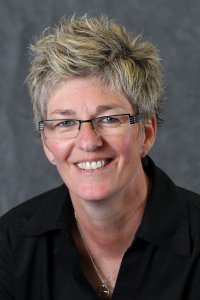When Stephen Foust announced his retirement as director of the Center for Innovation in Media, he left big shoes to fill. Stepping into them is journalist Val Hoeppner.
In close collaboration with college administrators, Foust opened the $700,000 facility in 2012 and has directed its operations since. The CIM houses all student media in addition to the university’s NPR station, WMOT 89.5.
Hoeppner has served as director of education for the Freedom Forum Diversity Institute and has spent 20 years in a variety of journalism roles, including multimedia director at The Indianapolis Star. She started teaching at MTSU in the fall of 2013 as the School of Journalism’s journalist in residence. During that time, she impressed students and faculty alike. In the classroom, her demeanor is casual and laid-back, but her progressive thinking and hands-on approach demand students’ attention. On July 1, she took over the CIM.
Hoeppner sat down with The Leading Edge for a Q&A to discuss her new role, expectations of up-and-coming Mass Comm students and the new “golden age of journalism.”
Will you continue any sort of teaching in your new role?
“In the fall, I’m going to teach a class with Leslie Haines (Visual Communication associate professor) called News Apps Design and Content. It’s a really cool class. We’re going to teach students how to create all of the content for an app. So it could writing, it could be photo galleries, it could be things like interactive and video content. Then Leslie, who is a designer by trade, is going to teach how to design and build the app. By the end of the course, we’ll actually have a functioning news magazine app. It’ll be in the iTunes store.”
What skills are people going to need to go into mass communication fields in the future?
“You need to be able to communicate in multiple ways on multiple platforms, so I think it’s still really incredibly important to be able to write well. It’s also important to be able to speak well, but that also means you have to be able to communicate in social media and visually, using video, photos, interactive, that kind of thing. So the skill set is varied. It used to be that you were a reporter and that’s all you did – you were a reporter and you wrote stories! But now, reporters are going to shoot video, take pictures, put them on the Web … they’re also going to create social media. Same thing for PR folks. You’re going to go out to run an event, and you’ll run the social media from it, and you’re probably going to produce a video for your client. Who knows what else!”
So what is a newspaper going to look like in 20 years? Will people even call it a newspaper?
“In 20 years, a newspaper is probably going to be a very rare commodity. There won’t be a lot of printed newspapers anymore. It’s just so much more effective to publish in the digital space. I don’t know if people will call it a newspaper anymore, but I think they’ll call it … boy, a source of news and information, I don’t know what that equals in the digital space. I hope it’s not a website. Sidelines (MTSU’s student-run newspaper) this year is going to go digital-only, and we’re struggling with that right here in the CIM. What do we tell people we are? We’re a media company, a news organization, what are we now? On a weekly basis, we won’t publish a newspaper. Right now news content is really all about tablets and smartphones. That’s where it’s going to go for the next five years, but whatever comes after that will be the next platform we have to develop for.”
What is your message to high school seniors or incoming freshmen who want to go into mass communication, but don’t really know what that looks like?
“I got into journalism to make a difference in people’s lives, and that hasn’t changed at all just because we aren’t printing newspapers or broadcast television is changing. I do think we are in a new golden age of journalism. Back in the ‘50s and ‘60s, we went through this golden age of journalism where we expanded what we covered and how we covered things. Things were changing very quickly back then, and now we’re in that same position again. I think young people who want to tell people’s stories have so many more options now. It’s really, really exciting for young people to be able to play in every sandbox we have.”
This story was written by 2014 public relations graduate Seth Caldwell.



Leave a Reply